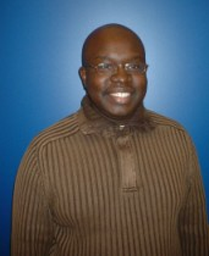Optimization of Pecvd Boron-Phosphorus doped Silicon Oxynitride for low-loss optical waveguides
Promotion date: 23 February 2007
| My thesis is about Silicon Oxynitride. That material is used in optical and electrical applications, e.g. in the Mesa+ Integrated Optical Microsystems Group to make waveguides. With the Silicon Oxynitride we can make various materials with different optical properties. The material however, has some fundamental problems when looking at actual telecom applications: to some extent it absorbs light and this means loss. I tried to find a means to improve the material by adding the Boron-Phosphorus. |
What gave you the idea to use Boron-Phosphorus?
In optics, silica is used to fill microchannels, but because of its melting temperature tiny gaps occur. With boron-phosphorus the melting temperature of silica is reduced.
That gave us the idea, but we started blind. It really was a wild guess.
And?
It works fine. The light absorption is decreased. Low loss is very important for telecom applications. In telecommunication transport of light means transport of information.
Could you call it a breakthrough?
Yes, but only for Silicon Oxynitride. But it has had a secondary result as well when making optical channels in the cleanroom. Up till now these channels always had a certain roughness at the surface, also resulting in loss of light. Also the problem of this roughness was solved.
Do you think that industry will adopt your material?
Yes, I certainly think they will. The results have already been published. It has been a success.
Where are you from?
I am from Sudan. I came here because of a collaboration with the University of Leiden.
In Leiden they have a program for small groups of foreign students to come and study here in the Netherlands. A colleague of mine did his master’s in Leiden and a PhD here in Mesa+. I also applied and did my master’s here. Then I got a PhD position.
So you have been here for quite some years?
Yes, since I also did my master’s here it adds up to 6 years.
And how do you look back on that?
Well, in Sudan we do not have the technology that is available here. You get to learn the basics. But after my BSc I went to China, but also that was fairly theoretical and I rather wanted to work on the application side of things. And this is an excellent environment to get into the track of applied physics.
I needed some help to get the hang of working in the cleanroom, but I got plenty of assistance.
Culturally of course there are enormous differences I had to get used to. And I will never get used to the weather. That is simply terrible for me, I am very sensitive to the fluctuations in the temperature.
What are your plans for the future?
Actually, in Sudan I have a position. After my graduation I took up a position as a teaching assistant at the university. Then after the Master’s I was promoted and became Lecturer and I will go back to lecturing. The PHD has given me much more experience which will be very useful for the university. I might even want to do a postdoc before I go back permanently

